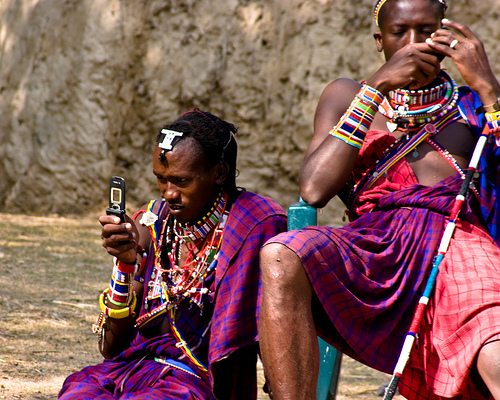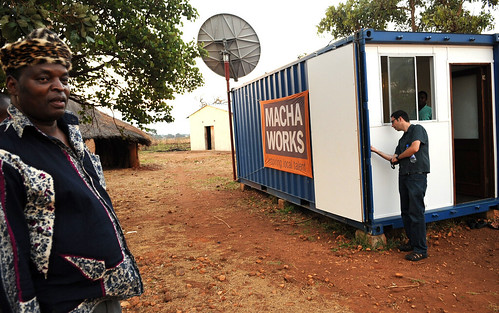 The mention of the word India may still call to mind visions of extreme poverty, but unlike other developing countries it is just as likely to make you think of software parks, call centers, and bustling businessmen jumping to catch the next flight to Silicon Valley. India has taken a fantastic leap into the 21st century over the last two decades and in doing so it taught everyone in the development community a lesson. It showed us that the IT sector could drive economic growth.
The mention of the word India may still call to mind visions of extreme poverty, but unlike other developing countries it is just as likely to make you think of software parks, call centers, and bustling businessmen jumping to catch the next flight to Silicon Valley. India has taken a fantastic leap into the 21st century over the last two decades and in doing so it taught everyone in the development community a lesson. It showed us that the IT sector could drive economic growth.
Since that time repeated efforts have been made to replicate India’s success. Many governments have targeted IT and ICT as a growth sector and development agencies continue to pour hundreds of millions of dollars (if not more) into this work every year. But the successes that governments and donors have brought about have been piecemeal. They help individuals and groups but have so far failed to bring about the revolutionary, economy-wide change that has been sought.
This disconnect between goals and results seems to call for some discussion. If it was indeed India that convinced us that IT could drive economies in the first place, perhaps we should take another look back at that case. After all, the lessons of India have been internalized to the point that they now form the basis of what we know as best-practice in ICT sector development: focus on the export sector, think about business process outsourcing, etc. Could it be that we have over learned these lessons?
The graph below presents the Indian IT boom in one picture. It shows IT exports in real US dollars over time, from 1980 to 2009, broken down by product classification.
This first glance reveals a few key insights. First, it confirms the widely accepted view that software exports (blue) were the driver of the IT boom. Note that sector output was already on an exponential growth path by the mid-to-late 1990s, before Business Process Outsourcing (BPO) began to register as an economic activity. Growth in the export of software paved the way for new business opportunities to emerge: first BPO, then training and design. The sector has diversified as it has grown, but that growth has always been on the back of software exports.
It also becomes clear that growth in software exports can be traced to the mid 1990s. A closer look reveals more.
At this scale it becomes clear that the boom actually began in 1992. By 1993 software was a billion-dollar export industry. To get to that point output more than doubled from the 1990-91 to the 1991-92 fiscal year. From that point export growth in the sector remained on average above 50% per annum for the next decade.
In explaining India’s software export growth the Economist Probab Sen noted that until the early 1990s, “the linear trend is consistently superior to the exponential…since then, however the semi-log trend starts dominating the linear.” Put simply, until the early 1990s, growth in software exports was linear. In 1992, the year of the boom, it became exponential. What happened?
Any attempt to answer that question would do well to recognize that India already had a successful and growing software industry by 1990. In 1980 India exported only four million dollars worth of software. By 1990 that number stood at 250 million. So the Indian ICT sector did not begin with the boom. Rather it began much earlier, more or less at the same time that it began in earnest in the United States – with the emergence of semiconductor and microprocessor technology the 1970s.
At that time India was poised to participate in the digital revolution like no other country in the developing world. The strong philosophy of “self reliance” present at independence led the country to found the Indian Institutes of Technology in the 1950s and 60s, creating a large cadre of technically savvy professionals, many of whom were working in the United States when the digital revolution began. Perhaps the most famous is Vinod Kholsa, an IIT graduate who pursued an advanced degree at Stanford’s Graduate School of Business and co-founded Sun Microsystems with two of his classmates there in 1982. In “The World is Flat” Tom Friedman claims that 25,000 Indian technologists like Mr. Kholsa have settled in the US since 1953.
While the first cohorts of IIT grads were pursuing graduate education in the west, new dynamics at play domestically resulted in companies developing an interest in software. In 1970 India became the first developing country to create a government office dedicated to electronics, and from 1972 its policy was to actively encourage software export. This created certain tax and customs incentives that were exploited by companies for their own financial gain.
Information technology was one of the few sectors where India’s protectionist government allowed foreign investment. IBM had a presence there by the mid 1970s, and it supplied a large amount of the mainframe computers in use in the country. These computers came with their own software, but as that software needed to be upgraded or modified, or as other uses came to be needed for the mainframe, software began to be developed inside of Indian companies, often by IIT graduates (importing software was too expensive). These companies then came to find that if they claimed some of this in-house software development was for export that the government would allow them to import hardware more cheaply. Consequently, some large companies that were not at all in the IT business began to spin-off software export arms – partially as a way of lowering their hardware costs.
Among the first to do this was the Tata group, a large conglomerate with interests in steel and automobiles. In 1974 Tata Consultancy Services (or TCS) became one of the first Indian software exporters, and it did so through a unique business model called “on-site software development.” TCS would send employees abroad to provide software support to western firms (mostly in the US), primarily on systems analysis and design. This labor was usually offered at less than 20% of what it would have cost the host company to hire locally. It was done on-site, rather than remotely, largely because telecommunications and data links between India and the west at that time were not good enough to allow remote work.
So not only did India have a valuable service to provide, but there were Indians on the buy-side in the US that were familiar with the skill set and work ethic offered by companies such as TCS. Throughout the 1980s this business began to grow, to the point that by 1989 it accounted for 90% of all Indian software exports. But it grew linearly. The primary input in this on-site software development, trained technologists, could only be procured through the technology institutions. These schools were already packed to the gills with students, and a set cohort came onto the market every year. They performed the same labor, under the same circumstances, and had a relatively constant level of productivity throughout the 1980s. The growth in software exports over that time can therefore be attributed to more workers and more clients, not to any particular type of innovation.
The Indian IT boom came when the sector changed in a way that allowed the productivity levels of these workers to increase dramatically. I’ll explore these changes in my next post.
Already in the Indian story questions are raised that are relevant for how we conduct ICT sector development work today. What is the role of the state? In India, protectionist policies were relaxed in such a way as to created incentives for companies to send software engineers abroad, laying the groundwork of the sector. Does that offer lessons for us in the era of free trade? What about the role of education? From the story thus far it seems central. Are we focusing in this area or are we siloed in an “Economic Growth” world? What about the role of foreign investors? Did IBM play a central role? Further, in our sector development efforts, are we trying to create an industry from scratch, and claim that it can drive an economy immediately? What are reasonable expectations?
Sources
Sen, Pronab “Indian Software Exports: An Assessment” Econmic and Political Weekly, February 18-25, 1995.
Kumar, Nagesh “Indian software Industry Development: International and National Perspective” Economic and Political Weekly, Novermber 10, 2001
Lateef, Asma 1997. “Linking up with the global economy, a case study of the Bangalore Software Industry,” NIOP, DP/96/97, Geneva: International Institute for Labor Statistics.
Kumar, Nagesh and K.J. Joseph, “Export of Software and Business Process Outsourcing from Developing Countries: Lessons from the Indian Experience” Asia-Pacific Trade and Investment Review, April 2005.
Arora, Ashih et. al, “The Indian Software Services Industry” Research Policy, October 2001.
Heeks, Richard “ICTs for Development” Personal Blog. Indian IT Sector Statistics: 1980-2009 Time Series Data.


















































